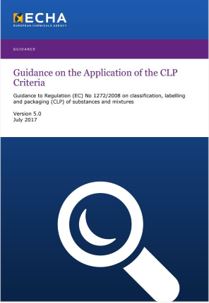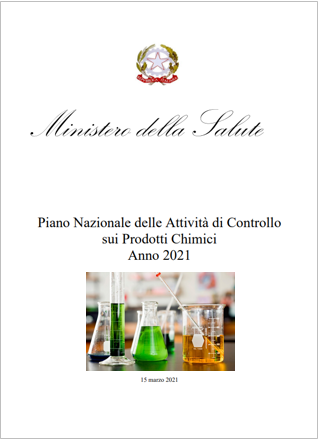Decreto Ministeriale 18 Febbraio 1939
Aggiunta al Prospetto allegato per i gas tossici
(G.U. 25.03.1939, n. 73)
Collegati
Regio Decreto 9 gennaio 1927 n. 147
Vademecum impiego gas tossici
Gas toss...
ECHA/NR/18/36
Scientific criteria have been agreed to identify endocrine disruptors under the EU legislation for pesticides and biocides. The criteria for biocides apply from 7 June 2018.
Pre-publication version of the Guidance for Identification of Endocrine Disruptors in the Context of the Biocidal Products and Plant Protection Products Regulations available
This Guidance was developed jointly by ECHA and the European Food Safety Authority (EFSA) with support by the Joint Research Centre (JRC) and describes how to identify endocrine disruptors in the context of the Biocidal Products Regulation (EU) No 528/2012 and the Plant Protection Products Regulation (EC) No 1107/2009 in accordance with the scientific criteria for the determination of endocrine disrupting properties set out in Commission Delegated Regulation (EU) 2017/2100 and Commission Regulation (EU) 2018/605. The final guidance will be published in the EFSA Journal by July 2018.
Helsinki, 7 June 2018
A drafting group consisting of scientific staff from ECHA and the European Food Safety Authority (EFSA), with the support of the Joint Research Centre (JRC), have developed scientific guidance to enable the identification of endocrine disruptors. The guidance advises applicants and assessors of the competent regulatory authorities on how to identify endocrine disruptors in accordance with the endocrine disruptor criteria.
The European Commission tasked ECHA and EFSA to develop the guidance to ensure harmonised implementation of the endocrine disruptor criteria throughout the EU for the assessment of biocides and plant protection products. The guidance has been consulted with the Agencies’ stakeholders, ECHA’s endocrine disruptor expert group and Member States’ biocides and pesticides competent authorities.
This guidance document is written to provide guidance to applicants and assessors of competent regulatory authorities on how to identify endocrine disruptors in accordance with the ED criteria laid down in Commission Delegated Regulation (EU) No 2017/2100 and Commission Regulation (EU) No 2018/605 for biocidal products (BP) and plant protection products (PPP), respectively. The guidance document describes how to gather, evaluate and consider all relevant information for the assessment,
conduct a mode of action (MoA) analysis, and apply a weight of evidence (WoE) approach, in order to establish whether the ED criteria are fulfilled.
The guidance document has been subject to several consultations which are summarised in a technical report (ECHA and EFSA, 2018) . It was consulted twice with an ad-hoc Consultation Group of Member States experts and stakeholders (April-May 2017 and July-August 2017). A general public consultation was held (December 2017-January 2018) to which any interested party could respond. A targeted consultation of risk assessors from competent authorities in the plant protection and biocidal product sectors were consulted in parallel with the EFSA Scientific Committee and the EFSA Panel on plant protection products and their residues (April 2018). Finally, risk managers of the competent authorities for biocidal products and of those for plant protection products were consulted, before adoption of the guidance by ECHA and EFSA according to their procedure (May 2018). When revising the guidance following the above consultations, the overall feedback received and the status of scientific knowledge was considered and it was acknowledged that the document, in future, may need to be revised, when relevant further scientific knowledge becomes available and on the basis of the experience acquired with the application of the present guidance document.
Chapter 3 presents the assessment strategy for determining whether a substance meets the ED criteria.
The strategy is based on the requirements outlined in the ED criteria. An approach is proposed for analysing the information provided in a dossier submitted for approval of a substance in the context of the PPP or BP Regulations.
Chapter 4 gives an overview on the information sources that may provide suitable information for ED identification and therefore should be considered for the assessment. In addition, Chapter 4 provides guidance on how to consider the scientific data generated in accordance with internationally agreed study protocols in order to facilitate the evaluation of both adverse effects and endocrine activity (by following the process explained in Chapter 3). The rationale for grouping effects is based on the ‘Guidance Document on standardised test guidelines for evaluating chemicals for endocrine disruption.
Series on Testing and Assessment No. 150’ provided by the Organisation for Economic Co-operation and Development (OECD) (OECD, 2018b) for their interpretation with regard to estrogenic, androgenic, thyroidal and steroidogenic (EATS) modalities and adapting the Joint Research Centre’s (JRC) screening methodology to identify potential endocrine disruptors (JRC, 2016).
Chapter 5 gives recommendations for applicants and assessors from evaluating authorities and for future research and Chapter 6 provides the references. The guidance is complemented with a list of abbreviations and a glossary of terms and definitions used in the text, and several appendices providing information on some specific scientific or technical issues (Appendix A – Additional considerations on how to assess the potential for thyroid disruption; Appendix B – Recommendations for design, conduct and technical evaluation of hormonal studies; Appendix C – Information requirements under the BP and PPP Regulations; Appendix D – Databases, software tools and literature-derived (Q)SARs; Appendix E – Excel template for reporting the available information relevant for ED assessment; Appendix F – Example on how to develop the search strategy protocol; and Appendix G – Example of MoA for nontarget organisms (fish)).
___________
LEGAL NOTICE
ABBREVIATIONS
GLOSSARY OF TERMS
1. INTRODUCTION
2. SCOPE OF THE GUIDANCE DOCUMENT
3. STRATEGY TO ASSESS WHETHER A SUBSTANCE MEETS THE ENDOCRINE DISRUPTOR CRITERIA
3.1. General overview of the assessment strategy
3.1.1. Grouping of parameters relevant for identification of endocrine disrupting properties
3.1.2. Considerations on non-EATS modalities
3.1.3. The assessment strategy
3.2. Gather all relevant information
3.2.1. Evaluate relevance and reliability of the data
3.2.1.1. Data from standard studies
3.2.1.2. Other scientific data
3.2.2. Extracting and reporting the information
3.3. Assemble and assess lines of evidence for endocrine activity and adversity
3.3.1. Assembling and assessing the line(s) of evidence for adverse effects
3.3.1.1. Effects secondary to other toxicities
3.3.1.2. Low-dose effects and non-monotonic dose response (NMDR)
3.3.1.3. Human relevance
3.3.1.4. Population relevance
3.3.2. Assembling and assessing the line(s) of evidence for endocrine activity
3.3.3. Integration of the lines of evidence for adverse effects and endocrine activity
3.3.4. Reporting the lines of evidence
3.4. Initial analysis of the evidence
3.4.1. Sufficient dataset for EATS-mediated adversity to support a conclusion on absence of EATS mediated adversity
3.4.2. Sufficient dataset for EATS-related endocrine activity to support a conclusion on absence of EATS-related endocrine activity
3.4.3. Considerations on the generation of further data
3.4.4. Scenarios
3.4.4.1. Scenarios based on ‘EATS-mediated’ parameters sufficiently investigated
3.4.4.2. Scenarios based on ‘EATS-mediated’ parameters not sufficiently investigated
3.5. Mode of Action (MoA) analysis
3.5.1. Postulate MoA(s) considering the adversity and/or endocrine activity
3.5.2. Establish the biologically plausible link
3.5.3. Consider which further information could help to clarify the postulated MoA(s)
3.5.4. Additional considerations for non-endocrine or non-EATS mediated MoA(s)
3.5.4.1. Biological plausibility for the key event relationships
3.5.4.2. Empirical support for dose–response/incidence and temporal concordance for the key event relationship
3.5.4.3. Essentiality, consistency, analogy and specificity of the evidence for the association of the KEs with the adverse effect
3.5.4.4. Human relevance
3.5.5. Extent of support for the overall assessment of the MoA analysis
3.5.6. Conclusion on the MoA analysis
3.6. Overall conclusion on the ED criteria
4. INFORMATION SOURCES FOR ENDOCRINE DISRUPTOR IDENTIFICATION
4.1. Non-test methods
4.2. In vitro test methods
4.3. In vivo test methods
4.3.1. Mammalian
4.3.1.1. OECD CF level 3 tests
4.3.1.2. OECD CF level 4 and 5 tests
4.3.2. Non-mammalian
4.3.2.1. Parameters
4.3.2.2. Fish
4.3.2.3. Amphibians
4.3.2.4. Birds
4.4. Epidemiological data, field studies and population models
4.4.1. Epidemiological data
4.4.2. Field studies and monitoring data
4.4.3. Population models
5. RECOMMENDATIONS
5.1. Recommendations for applicants and assessors
5.2. Recommendations for future research
6. REFERENCES
APPENDIX A – ADDITIONAL CONSIDERATIONS ON HOW TO ASSESS THE POTENTIAL FOR THYROID DISRUPTION FOR HUMAN HEALTH
APPENDIX B – RECOMMENDATIONS FOR DESIGN, CONDUCTION AND TECHNICAL EVALUATION OF HORMONAL STUDIES
APPENDIX C – INFORMATION REQUIREMENTS FOR ACTIVE SUBSTANCES UNDER THE BIOCIDAL PRODUCTS AND PLANT PROTECTION PRODUCTS
REGULATIONS, WHICH COULD POTENTIALLY PROVIDE INFORMATION ON ENDOCRINE-DISRUPTING PROPERTIES
APPENDIX D – DATABASES, SOFTWARE TOOLS AND LITERATURE-DERIVED (Q)SARS
APPENDIX E – EXCEL TEMPLATE FOR REPORTING THE AVAILABLE INFORMATION RELEVANT FOR ED ASSESSMENT
APPENDIX F – EXAMPLE ON HOW TO DEVELOP THE SEARCH STRATEGY PROTOCOL
APPENDIX G – EXAMPLE OF MOA FOR NON-TARGET ORGANISMS (FISH)
Fonte: ECHA
Collegati:
Aggiunta al Prospetto allegato per i gas tossici
(G.U. 25.03.1939, n. 73)
Collegati
Regio Decreto 9 gennaio 1927 n. 147
Vademecum impiego gas tossici
Gas toss...

Versione 5.0
Questa guida è un documento tecnico e scientifico completo sull'applicazione del regolamento (CE) n. 1272/2008 relativo alla cl...

A cura di Ministero della Salute Anno 2021
Il Piano è stato predisposto dal Ministero della Salute con la collaborazione del Gruppo ...
Testata editoriale iscritta al n. 22/2024 del registro periodici della cancelleria del Tribunale di Perugia in data 19.11.2024